John Hurrell – 26 January, 2016
The ‘burning' fencing can also be seen to have a loaded meaning, such as the dissolution of the concept of private property, while perhaps the broom represents the sweat of rudimentary labour. Putting the two together suggests there's a discrepancy between the manual activity and possible rewards that need to be protected behind high walls, working hard for material goods and yet (here unsuccessfully) keeping those acquisitions ‘secure'.
Auckland
Eddie Clemens
Delusional Architecture (Commemorative)
20 January - 13 February 2016
While these two light sculptures of Clemens have been presented before separately at Sue Crockford, St Paul St Gallery 3, Gus Fisher, Papakura Art Gallery and Snake Pit, it is good to see them gathered together in the Bowerbank Ninow space as an organised installation.
Here their combination has considerable wit: the rippling rainbow hues of the broom with fibre optic bristles (radiating garish patterns out of the centre of its head) being a foil to the subtle twinkling ‘embers’ of the pulled apart netting fence. Brooms are used to contain material, to collect and confine it. Wire netting fences that have sections cut out release imprisoned material so it can freely disperse. Designed also to keep people out, these breached fences appear to burn like toppled barricades that have been set alight by catastrophic conflagratory forces and which are still smouldering. The slowly fading or intensely brightening LEDs have sections that lie dormant and dark for long periods, to then become active and pulse like living breathing creatures.
The collapsed netting barriers (with their cinders) reference James Cameron’s movie Terminator 2 where there is a scene of breached fencing dramatically glowing at its edges, while the broom seems to allude to the performances of Joseph Beuys, or in this country, some of the early eighties ‘process’ sculptures of Warren Viscoe that trapped loose gravel swept along wooden planks (with cross-batons) laid on the floor (1). Clemens wisely only includes one broom, for two or more brightly glowing and pulsing bristle heads would destroy the subtlety of the changing ragged lines of orange embers on the Cyclone fencing. They need a certain amount of darkness to work.
The ‘burning’ fencing can also be seen to have a loaded meaning, such as the dissolution of the concept of private property, while perhaps the broom represents the sweat of rudimentary labour. Putting the two together suggests there’s a discrepancy between the manual activity and possible rewards that need to be protected behind high walls, working hard for material goods and yet (here unsuccessfully) keeping those acquisitions ‘secure’.
When you think about the fences further, genuine metal netting would be very different from this beguiling fiction of Clemens’ made of meticulously woven plastic cable with small, oval, wired up, circuit boards and LEDs . The steel net would have to be cut through using pliers or two-handed cutters, or with an acetylene blowtorch that would leave charred tips.
One of the rectangular sections of this barrier has small extractor fans embedded into the mesh and these sucking fans hold up tissues that fall down when the fans are turned off. This apparently was inspired by Clemens visiting Coney Island in New York where he spotted wind-blown paper stuck in the netting. It might also refer to A Hundred Breaths, a Mike Parr performance work where he used his lungs and mouth to hold (in sequence) a series of a hundred self-portrait etchings against his face, one at a time.
The colourful broom (as well as a similar scrubbing brush work in the gallery office) is programmed to present a unique configuration of sliding patterns generated by the artist sweeping (or scrubbing) the gallery floor. There is a Gyrometer inserted into the head that records the tilting patterns (balancing angles) of the tool’s performative usage, and the details of performer and location of that action are typed in to be presented like an electronic noticeboard.
In the narrow corridor adjacent to the office is a trio of non-light works, three wall sculptures made from top range tennis rackets, each with its own particular variety of high tensile string. The grid of strings for each has been set within an oval of aggregate-mixed concrete, the wooden components (frame and handle) removed, and the front surface polished and ground flat. The string ends are left protruding.
There is a wonderful humour to this act of vandalism where a sports implement linked to the speed and power of the moving human body is blended with the weight and solidity of concrete embedded with stone chips. What is airbound, delicate and high becomes something else normally felt underfoot. Abstract and obliquely enigmatic, they as mutilated pieces of equipment are fascinating foils to the much more obvious fencing and broom, and to a (John Ward Knoxlike) chain spider’s web in the office where the chains hold suspended (ink dripping) biros like hanging fly carcasses. The biros reference bank and post offices where biros are placed next to paper slips on desks, but attached to lengths of fine chain so light-fingered customers can’t remove them. There is a creepy metaphor at work here in Clemens’ sculpture - alluding to spiders and flies - about corporate customer as manipulated victim.
John Hurrell
(1) Shown in Christchurch as part of ANZART in August 1981.
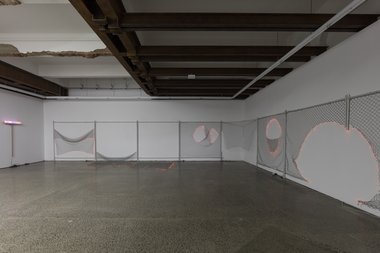
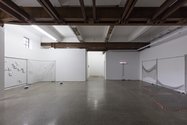
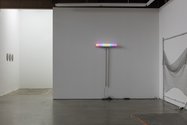




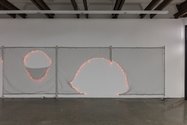
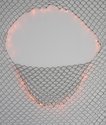
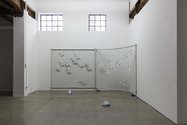


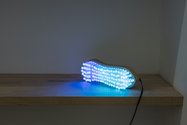
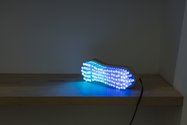
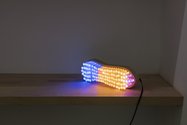



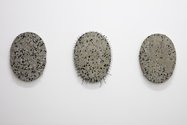



 Two Rooms presents a program of residencies and projects
Two Rooms presents a program of residencies and projects Advertising in this column
Advertising in this column



This Discussion has 0 comments.
Comment
Participate
Register to Participate.
Sign in
Sign in to an existing account.